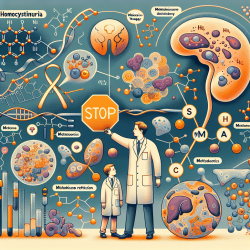Introduction
Homocystinuria, a genetic disorder caused by cystathionine beta-synthase (CBS) deficiency, affects sulfur amino acid metabolism, leading to a variety of complications. A recent study titled "Deciphering pathophysiological mechanisms underlying cystathionine beta-synthase-deficient homocystinuria using targeted metabolomics, liver proteomics, sphingolipidomics and analysis of mitochondrial function" provides new insights into the disease mechanisms using a transgenic mouse model. This blog will explore how practitioners can utilize these findings to enhance therapeutic outcomes for children with this condition.
Key Findings from the Study
The study utilized a comprehensive approach involving targeted metabolomics, liver proteomics, and sphingolipidomics to investigate CBS-deficient homocystinuria. Here are some of the significant findings:
- Metabolite Compartmentalization: The research revealed distinct compartmentalization of sulfur-related metabolites in normal mice. This finding is crucial as it indicates that metabolic changes in plasma and urine do not necessarily reflect tissue conditions.
- Liver Proteome Dysregulation: The study identified significant dysregulation in the liver proteome of CBS-deficient mice, affecting biological oxidations and metabolism of amino acids, vitamins, cofactors, and lipids.
- Sphingolipid Signaling Pathway: An upregulation of the sphingosine-1-phosphate signaling pathway was observed, indicating potential targets for therapeutic intervention.
- Mitochondrial Function: Interestingly, liver mitochondrial function in CBS-deficient mice was not impaired, suggesting that mitochondrial dysfunction might not be a primary concern in this model.
- Effectiveness of Methionine-Restricted Diet (MRD): The study demonstrated that MRD improved metabolic balance and reduced liver proteome dysregulation, highlighting its therapeutic potential.
Implications for Practitioners
Practitioners working with children diagnosed with homocystinuria can draw several practical applications from this study:
- Personalized Treatment Plans: Understanding the distinct tissue compartmentalization of metabolites can aid in tailoring personalized treatment plans that address specific metabolic imbalances in patients.
- Emphasis on Dietary Management: The effectiveness of MRD in reducing metabolic and proteomic disbalances underscores the importance of dietary management as a cornerstone of therapy for non-responsive patients.
- Potential for New Therapies: The identification of dysregulated pathways, such as the sphingosine-1-phosphate signaling, opens avenues for developing targeted therapies that could complement existing treatments.
Encouraging Further Research
While this study provides valuable insights, it also highlights the need for further research. Practitioners are encouraged to engage in or support research initiatives that explore the molecular mechanisms underlying homocystinuria. Such efforts can lead to the development of novel therapeutic strategies and improve patient outcomes.
To read the original research paper, please follow this link: Deciphering pathophysiological mechanisms underlying cystathionine beta-synthase-deficient homocystinuria using targeted metabolomics, liver proteomics, sphingolipidomics and analysis of mitochondrial function.










